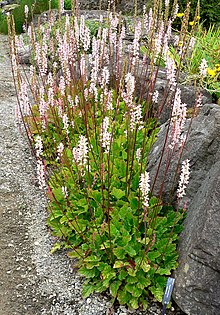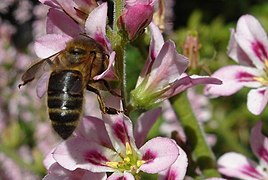
Kalmia latifolia, the mountain laurel, calico-bush, or spoonwood, is a species of flowering plant in the heath family Ericaceae, that is native to the eastern United States. Its range stretches from southern Maine south to northern Florida, and west to Indiana and Louisiana. Mountain laurel is the state flower of Connecticut and Pennsylvania. It is the namesake of Laurel County in Kentucky, the city of Laurel, Mississippi, and the Laurel Highlands in southwestern Pennsylvania.

Petunia is a genus of 20 species of flowering plants of South American origin. The popular flower of the same name derived its epithet from the French, which took the word pétun, 'tobacco', from a Tupi–Guarani language. A tender perennial, most of the varieties seen in gardens are hybrids.

Dasiphora fruticosa is a species of hardy deciduous flowering shrub in the family Rosaceae, native to the cool temperate and subarctic regions of the northern hemisphere, often growing at high altitudes in mountains. Dasiphora fruticosa is still widely referenced in the horticultural literature under its synonym Potentilla fruticosa. Common names include shrubby cinquefoil, golden hardhack, bush cinquefoil, shrubby five-finger, widdy, and kuril tea.

Primula vulgaris, the common primrose, is a species of flowering plant in the family Primulaceae, native to western and southern Europe, northwest Africa, and parts of southwest Asia. The common name is primrose, or occasionally common primrose or English primrose to distinguish it from other Primula species also called primroses. None of these are closely related to the evening primroses.

Tradescantia pallida is a species of spiderwort native to the Gulf Coast region of eastern Mexico. The cultivar T. pallida 'Purpurea' is commonly called purple secretia, purple-heart, or purple queen. Edward Palmer collected the type specimen near Ciudad Victoria, Tamaulipas in 1907.

Hydrangea macrophylla is a species of flowering plant in the family Hydrangeaceae, native to China. It is a deciduous shrub growing to 2 m (7 ft) tall by 2.5 m (8 ft) broad with large heads of pink or blue flowers in summer and autumn. Common names include bigleaf hydrangea, French hydrangea, lacecap hydrangea, mophead hydrangea, and hortensia. It is widely cultivated in many parts of the world in many climates. It is not to be confused with H. aspera 'Macrophylla'.

Erica carnea, the winter heath, winter-flowering heather, spring heath or alpine heath, is a species of flowering plant in the family Ericaceae, native to mountainous areas of central, eastern and southern Europe, where it grows in coniferous woodlands or stony slopes.

Lavandula angustifolia, formerly L. officinalis, is a flowering plant in the family Lamiaceae, native to the Mediterranean. Its common names include lavender, true lavender and English lavender ; also garden lavender, common lavender and narrow-leaved lavender.

Ribes sanguineum, the flowering currant, redflower currant, red-flowering currant, or red currant is a North American species of flowering plant in the family Grossulariaceae, native to the western United States and Canada.
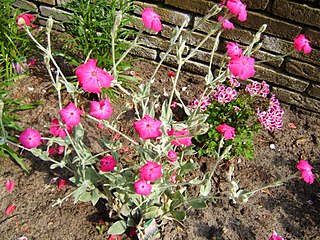
Silene coronaria, the rose campion, is a species of flowering plant in the family Caryophyllaceae, native to Eurasia. Other common names include dusty miller, mullein-pink and bloody William. In the United Kingdom it is still widely referenced under its synonym Lychnis coronaria.

Emilia sonchifolia, also known as lilac tasselflower or cupid's shaving brush, is a tropical flowering species of tasselflower in the sunflower family. It is widespread in tropical regions around the world, apparently native to Asia and naturalized in Africa, Australia, the Americas, and various oceanic islands.

Phlox subulata the creeping phlox, moss phlox, moss pink or mountain phlox, is a species of flowering plant in the family Polemoniaceae, native to eastern and central USA, and widely cultivated.

Viburnum plicatum is a species of flowering plant in the family Adoxaceae, native to mainland China, Korea, Japan, and Taiwan. The Latin specific epithet plicatum means "pleated", referring to the texture of the leaves.

Pieris japonica, the Japanese andromeda or Japanese pieris, is a species of flowering plant in the heath family Ericaceae. It is native to eastern China, Taiwan, and Japan, where it grows in mountain thickets. This medium-sized evergreen shrub or tree is widely cultivated in gardens.

Aster amellus, the European Michaelmas daisy, is a perennial herbaceous plant and the type species of the genus Aster and the family Asteraceae.
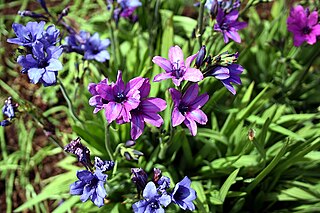
Babiana stricta, the baboon flower or blue freesia, is a species of flowering plant in the family Iridaceae, native to Cape Province, South Africa and naturalized in Australia.

Hylotelephium cauticola, the cliff stonecrop, syn. Sedum cauticola, is a species of flowering plant in the family Crassulaceae, native to Hokkaido, Japan. Growing to 8 cm (3 in) tall by 30 cm (12 in) wide, it is a carpet-forming succulent perennial with trailing stems of pink-tinged grey-green round leaves, and purplish pink star-shaped flowers in autumn.

Cyclamen purpurascens, the purple cyclamen, is a species of flowering plant in the genus Cyclamen of the family Primulaceae, native to central Europe, northern Italy, and former Yugoslavia. It is an evergreen tuberous perennial with (usually) variegated leaves, and deep pink flowers in summer.

Scilla bifolia, the alpine squill or two-leaf squill, is a herbaceous perennial plant growing from an underground bulb, belonging to the genus Scilla of the family Asparagaceae.
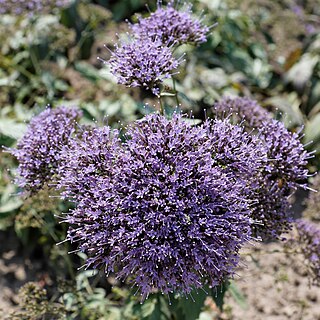
Trachelium caeruleum, common name blue throatwort, is a species of flowering plant in the family Campanulaceae native to the Mediterranean, where its native range includes Algeria, Morocco, Portugal, Spain, and Sicily. It has also become naturalized in a few areas, including New Zealand, the Azores, and parts of mainland Europe.
